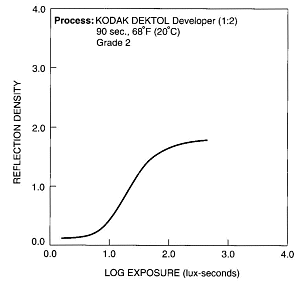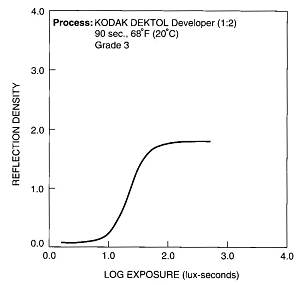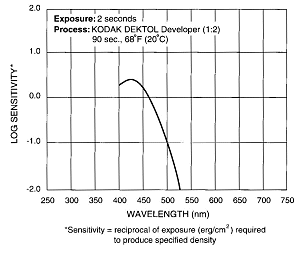KODAK P -MAX Art R C
PA P E R
KODAK P-MAX Art RC Paper is a fast resin-coated black-and-white
enlarging paper designed for hand coloring with oil paints, liquid or dry
dyes, pastels, and pencils. It features a neutral- to warm-black image
tone, excellent "tooth," and a double-matt surface that make it an excellent
choice for fine-art applications. It is available in two contrast grades
in sheets from 8 x 10 inches to 20 x 24 inches.
This paper has an incorporated developing agent. You can process it
in the KODAK ROYALPRINT Processor, Model 417; in roller-transport or continuous
processors; or in trays.
| FEATURES |
BENEFITS |
-
Double-matt surface that provides excellent "tooth"
|
-
Can be hand-colored with oil paints, dyes, pastels, and pencils
-
Good writing surface
|
|
|
-
Allows printmakers to customize prints
|
-
Available in two contrast grades
|
-
Suits a variety of applications
|
-
Resin-coated, water- resistant base
|
-
Rapid processing, fast drying, and minimum curl
|
BASE AND SURFACE CHARACTERISTICS
| Symbol |
Texture |
Surface |
Base
Tint |
Base
Weight |
| V |
Suede |
Double
matt |
White |
Heavy
weight |
STORAGE AND HANDLING
Store unexposed paper in a cool, dry place (preferably at or below
70F [21C] and at a relative humidity of 30 to 50 percent). High temperatures
or high humidity may produce undesirable changes. Always rewrap unused
paper in its original packaging (use the outer box as well as the bag)
to protect it from light and moisture. Avoid or shield paper from exposure
to radioactivity or x-rays.
SAFELIGHT RECOMMENDATIONS
Use a KODAK OC Safelight Filter (light amber) in a suitable safelight
lamp with a bulb of 15 watts or less at least 4 feet (1.2 metres) from
the paper. Minimize safelight exposure to avoid unwanted quality changes.
Be especiallg careful if you use other types of safelights.
See KODAK Publication No. K-4, Hou Safe Is Your Safelight?, for
information on safelight testing. Do not use a KODAK OA Safelight
Filter (greenish yellow).
EXPOSURE
This paper is designed for exposure with tungsten or tungsten-halogen
enlarging lamps. You can also use other light sources such as cool-white
fluorescent lamps, mercury-vapor lamps, and cathode-ray tubes. Make trial
exposures to determine the optimum exposure.
Paper Speed and Range
Contrast
Grade |
Effective
Paper Speed |
Log Exposure
Range |
| 2 |
400 |
0.91 to 1 .15 |
| 3 |
400 |
0.66 to 0.90 |
PROCESSING
Machine
You can process this paper in roller-transport processors (e.g., the
KODAK POLYMAX IR Paper Processor) or continuous processors with KODAK POLYMAX
RT Developer and Replenisher and KODAK POLYMAX RT Fixer and Replenisher
or KODAK Rapid Fixer, Part A.
For rapid processing of this paper, you can use the KODAK ROYALPRINT
Processor, Model 417, with KODAK ROYALPRINT Chemicals.
Tray
Tray develop with continuous agitation at 68F (20C), using the appropriate
dilution and development time recommended in the following table.
KODAK
Chemical |
Dilution
(chemical:
water) |
Time
(min:sec) |
Capacity
(8 x 10-inch
Prints
per gal/L) |
| Developer- 68F (20C) |
| DEKTOL |
1:2 |
1:00 |
120/32 |
| POLYMAX T |
1:9 |
1:00 |
120/32 |
| EKTONOL* |
1:1 |
1:30 |
120/32 |
| D-72 (formula) |
1:2 |
1:00 |
100/26 |
| Stop Bath-65 to 75 F.(18 to. 24C) |
| Indicator |
1:64 |
0:10 |
80/20t |
| EKTAFLO |
1:31 |
0:10 |
80/20t |
| Fixer/Replenisher (single bath)# 65
to 75F (18 to 24C) |
| Nonhardening fixer (for general printing
and for toning): |
Rapid Fixer,
Solution A (do not
use Solution B) |
1:7 |
2:00 |
100/26 |
| Hardening fixers (for general printing): |
| KODAK Fixer |
PaPer
strength |
2:00 |
100/26 |
| POLYMAX T |
1:7 |
2:00 |
100/26 |
Rapid Fixer
(Solution A and B) |
1:7 |
2:00 |
100/26 |
| KODAFIX Solution |
1:7 |
2:00 |
100/26 |
| Wash 50 to 86F (10 to 30 C) |
|
- |
4:00 |
- |
* Provides greater development latitude.
t Discard the solution when color changes to a purplish
blue.
# To increase capacity, use two fixing baths.
Stop Bath
Bathe prints for at least 10 seconds at 65 to 75F (18 to 24C)
with continuous agitation in KODAK EKTAFLO Stop Bath, KODAK Indicator Stop
Bath, or 48 mL KODAK 28% Acetic Acid and water to make 1 L.
With EKTAFLO or Indicator Stop Bath, discard the solution when the
color changes to a purplish blue. Change Acetic Acid and water stop bath
after approximately twenty 8 x 10-inch prints per litre (eighty 8 x lOs
per gallon).
Fixing
Fix prints at 65 to 75F (18 to 24C) with frequent agitation. If you
use two fixing baths, fix prints for
1 minute in each bath, draining for 5 seconds between baths. Fix for
2 minutes if you use a single bath.
Note: Using a hardening fixer makes toning less efficient. For
the same amount of processing time, you'll see less of a toning effect.
Washing
Wash for at least 4 minutes in running water at 50 to 86F (10 to 30C),
interleaving the prints carefully and frequently.
Drying
Air-dry at room temperature after removing surface water with a clean,
lintless blotter or cloth, or a soft squeegee or sponge. You can also dry
prints with warm air, or use a dryer intended for resin-coated papers.
Do not ferrotype prints made on this paper. You can use.ferrotype
dryers (glazing machines) below 190F (88C) if you squeegee the prints and
feed them base side toward the drum surface.
TONING
Use KODAK Toners to extend the life of prints that may be exposed to
oxidizing gases or subjected to adverse storage or display conditions.
KODAK Toners will protect prints whether or not they produce a tone shift.
| Processing |
Tone Shift with KODAK Toners |
| Full |
Moderate |
Slight |
None |
Tray (with
DEKTOL
Developer
[1:2]) |
Brown |
POLY TONER
(1:24, 1:50) |
POLY TONER
(1:4) |
Rapid
Selenium
(1:3, 1:9
1:20, 1:40) |
| Sepia |
For more information on toning, see KODAK Publication G-23,
Toning KODAK Black-and-White Materials. It explains the technique of toning,
and describes Kodak toners and their effects on Kodak black and-white papers
and films.
HAND-COLORING
You can hand-color prints on this paper with a variety of color media.
Use one or a combination of oil paints, dyes, pastels, or pencils to achieve
the results you want.
Before you begin, here are a few tips:
-
Work with prints that are at least 15 percent lighter than normal.
-
Natural-looking skin tones are easier to reproduce if prints are toned
with KODAK Sepia Toner (CAT 169 1757) or KODAK Brown Toner (CAT 146 4452).
-
Color lighter tones first (i.e. fair skin) as a guide for darker tones.
You'll need the following materials:
-
Color media
-
White, non-porous palette (palette with "wells" for holding liquid dyes)
-
Applicators-sable brushes, cotton swabs, loose natural cotton, toothpicks,
wooden skewers, paper towels
-
Removers-kneaded rubber eraser, 5-percent clear, pure household ammonia
-
Spray lacquer
-
Steam source (for setting dry dyes)
Transparent Oils
Transparent oils, such as MARSHALL's Photo Oils, can help you
achieve a broad range of results. They are easy to apply and remove, allow
print details to show through, and are made specifically for use on photographic
surfaces.
-
Wipe the print with a cotton tuft moistened in MARSHALL's P.M. Solution
or equivalent.
-
Dry the print with a clean tuft.
-
Apply small amounts of color with a cotton tuft or swab, using a circular
motion.
-
Rub the color to a thin, even layer with clean cotton.
-
Remove any stray color using MARSHALL's P.M. Solution or a kneaded rubber
eraser.
-
Clean out the highlights with a dry cotton swab to give the colored areas
more definition.
-
Buff the highlight edges with cotton.
-
When the print is completely dry, spray several light, even coats of a
photographic lacquer over the finished print.
Liquid Retouching Dyes
Liquid retouching dyes, such as those in the KODAK Liquid Retouching
Color Set (CAT 190 1743), are useful for achieving brilliant hues in small
areas.
-
Use distilled water to premoisten large areas that you plan to color. For
small areas, apply dye using controlled brush strokes or a stippling action.
For larger areas, dilute dyes with distilled water, and use a "wash" or
watercolor technique.
-
Remove liquid dye by wiping it with 5-percent clear ammonia, followed by
distilled water.
-
Apply a final coat of lacquer (optional).
Dry Dyes
Dry dyes, such as KODAK Retouching Colors (CAT 189 0888), are
well suited for coloring large areas and achieving subtle, pastel tones.
-
Dry the print thoroughly with a hair dryer to remove any residual moisture.
-
Soften the dye cake by breathing on the cake of dye. Do not use ,uater
to soften the cake.
-
Pick up dye from the cake and apply with a cotton tuft, working in a circular
motion, and covering the area completely.
-
Buff the colored area with clean cotton until the color is smooth and even.
-
For more definition, remove color from the highlights using cotton and
Remover for KODAK Retouching Colors (CAT 194 6730).
-
Buff to blend the edges.
-
To set the color, hold the print 6 to 8 inches from a steam source for
10 seconds, or until the waxy appearance disappears.
-
Remove unwanted dye before steaming with Remover for KODAK Retouching Colors.
Remove it after steaming with 5 percent clear ammonia.
-
Apply a final coat of lacquer (optional).
Other Coloring Options
there are many color media options, each with a different
wet of colorfastness and ease of use. The following are
st a few suggestions. Experiment, and see what suits
dour style and subjects best. Use your imagination.
-
Pastels-for soft-looking, large-area applications
-
Opaque oils and acrylics-for a brush-painted look
-
Pencils-for small details
-
Felt-tipped markers-for selective color and bold graphics
-
Oil sticks-for the combined qualities of opaque oils and pastels
-
Airbrush-for even color with good control
-
Watercolors-for delicate, luminous color
-
Food dyes and natural plant dye-for effective, inexpensive color
-
Artists inks-for a wide range of strong colors
Characteristic Curves
 |
 |
Spectral-Sensitivity Curves
 |
NOTICE: The sensitometric curves and data
in this publication represent product tested under the conditions of exposure
and processing specified. They are representative of production coatings,
and therefore do not apply directly to a particular box or roll of photographic
material. They do not represent standards or specifications that must be
met by Eastman Kodak Company. The company reserves the right to change
and improve product characteristics at any time.
MORE INFORMATION
Kodak has many publications to assist you with informa tion on
Kodak products, equipment, and methods. The following pamphlets are available
from Kodak through the order form in KODAK Publication No. L-1,
KODAK Index to Photographic In formation. To obtain a copy of
L-1, send your request with $1 to Eastman Kodak Company, Department 412-L,
Rochester,
New York 14650-0532.
E-67 Finishing Prints on KODAK Water-Resistant
Papers
G-23 Toning KODAK Black-and-White Materials
K-4 Hou Safe Is Your Safelight?
O-10 Retouching Black-and-White Negatives and
Prints
The following book is available from photo-specialty dealers who sell
Kodak products:
R-20 KODAK Black-and-White DATAGUIDE
Kodak, Kodafix, P-Max, Polymax, Dektol, Ektafio, Royalprint, Ektonol,
Kodafix, Poly-Toner, and Dataguide are trademarks.
|




